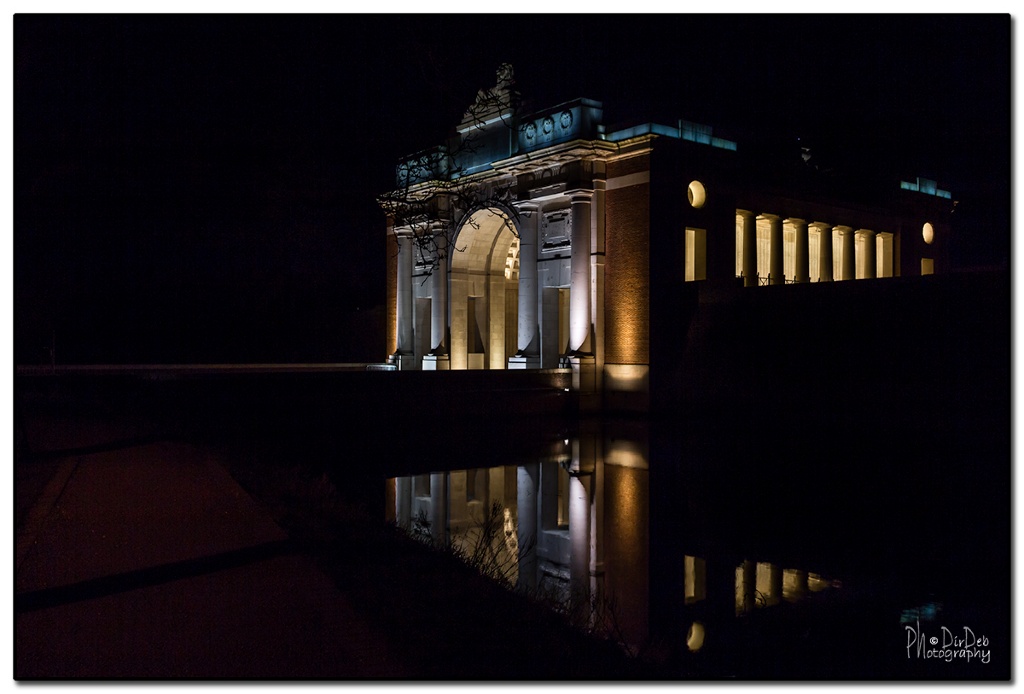Ypres (Menin Gate) Memorial
- Country Belgium
- Total identified casualties 54580 Find these casualties
- Region West-Vlaanderen
- Identified casualties from First World War
- GPS Coordinates Latitude: 50.8521, Longitude: 2.89138
PLEASE NOTE
Due to planned restoration works, access to the memorial is limited.
Please use the link below for more information.
The Last Post ceremony will still take place every evening at 20:00.
Location information
Ypres (now Ieper) is a town in the Province of West Flanders. The Memorial is situated at the eastern side of the town on the road to Menin (Menen) and Courtrai (Kortrijk). Each night at 8 pm the traffic is stopped at the Menin Gate while buglers of the Last Post Association sound the Last Post in the roadway under the Memorial's arches. For more information on the Last Post Association please check their website: www.lastpost.be.
Visiting information
A two year restoration programme is underway to guarantee the long-term preservation of the Memorial. For current visitor information, including access and arrangements for the Last Post Ceremony please see https://www.cwgc.org/our-work/menin-gate-memorial/
Panel Numbers quoted at the end of each entry relate to the panels dedicated to the Regiment with which the casualty served. In some instances, where a casualty is recorded as attached to another Regiment, his name may appear within their Regimental Panels. Please refer to the on-site Memorial Register Introduction. All odd panel numbers are on the North side of the road and even numbers are located on the South side of the road.
Please note that wreaths placed at the Memorial are regularly checked and removed as necessary.
History information
The Menin Gate is one of four memorials to the missing in Belgian Flanders which cover the area known as the Ypres Salient. Broadly speaking, the Salient stretched from Langemarck in the north to the northern edge in Ploegsteert Wood in the south, but it varied in area and shape throughout the war.
The Salient was formed during the First Battle of Ypres in October and November 1914, when a small British Expeditionary Force succeeded in securing the town before the onset of winter, pushing the German forces back to the Passchendaele Ridge. The Second Battle of Ypres began in April 1915 when the Germans released poison gas into the Allied lines north of Ypres. This was the first time gas had been used by either side and the violence of the attack forced an Allied withdrawal and a shortening of the line of defence.
There was little more significant activity on this front until 1917, when in the Third Battle of Ypres an offensive was mounted by Commonwealth forces to divert German attention from a weakened French front further south. The initial attempt in June to dislodge the Germans from the Messines Ridge was a complete success, but the main assault north-eastward, which began at the end of July, quickly became a dogged struggle against determined opposition and the rapidly deteriorating weather. The campaign finally came to a close in November with the capture of Passchendaele.
The German offensive of March 1918 met with some initial success, but was eventually checked and repulsed in a combined effort by the Allies in September.
The battles of the Ypres Salient claimed many lives on both sides and it quickly became clear that the commemoration of members of the Commonwealth forces with no known grave would have to be divided between several different sites.
The site of the Menin Gate was chosen because of the hundreds of thousands of men who passed through it on their way to the battlefields. It commemorates casualties from the forces of Australia, Canada, India, South Africa and United Kingdom who died in the Salient. In the case of United Kingdom casualties, only those prior 16 August 1917 (with some exceptions). United Kingdom and New Zealand servicemen who died after that date are named on the memorial at Tyne Cot, a site which marks the furthest point reached by Commonwealth forces in Belgium until nearly the end of the war. New Zealand casualties that died prior to 16 August 1917 are commemorated on memorials at Buttes New British Cemetery and Messines Ridge British Cemetery.
The YPRES (MENIN GATE) MEMORIAL now bears the names of more than 54,000 officers and men whose graves are not known. The memorial, designed by Sir Reginald Blomfield with sculpture by Sir William Reid-Dick, was unveiled by Lord Plumer on 24 July 1927.






